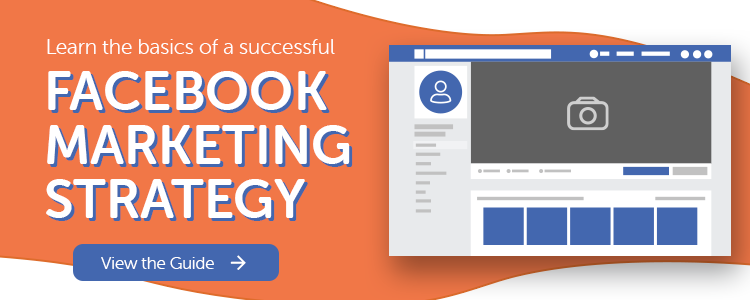Dark posts are a mysterious social marketing trend, and the spooky name doesn’t help much.
Delve a little deeper, though, and you’ll learn there’s nothing scary about Facebook dark posts.
Facebook dark posts occupy an interesting niche in a Facebook marketing strategy, and in social media advertising as a whole. You might not use them all the time, but it’s important to know them. They’re one more way you can get past the platform’s notorious organic reach problem and get the most from your ad investment.
Shining a Light: What Are Facebook Dark Posts?
First of all: There’s nothing shady about Facebook dark posts.
In fact, they’re officially called “unpublished posts”– which describes them much better.
Simply put, a published post appears on your Facebook page. On the other hand, an unpublished post never appears on the Facebook page.
They're considered "unpublished" because they're not like boosted and organic posts. They are simply targets ads that don't show up in your followers' feeds. Rather, they appear as sponsored content in the feeds of users who you are specifically targeting.
This concept actually adds a tremendous amount of flexibility to your advertising, letting you experiment with a number of new techniques without the risk of cheesing off your followers.
We all know that Facebook fans – and anyone tuned into social media – can run into ad fatigue. This is one reason it’s important to constantly rotate your ads. With dark posts, you can be more experimental and find approaches that work without exhausting those watching you.
There are actually many advantages to giving dark posts a try:
Superior Targeting
Since you have the chance to create as many ads as you want without spamming your followers, you can go deep into your segmentation strategy. This is great if you have several buyer personas and plan to hypertarget your ads with sophisticated filters using multiple interests and Groups.
Better Split Testing
Split testing delivers the data you need to refine your strategy and boost your ROI. With dark posts, you have a new way to capture insights on the best headline, body copy, and calls to action (CTAs). That helps you save money in the long run if you pursue a more aggressive strategy later.
Feed Diversification
Let’s face it: Nobody really wants to follow a brand page that’s nothing but ads. Facebook dark posts help you avoid the unhappy distinction of being the company nobody wants to hear from, making some ads “quieter” so you can improve the ad-to-content ratio most users will see.
How to Set Up Facebook Dark Posts
You can use Facebook dark posts for a wide range of content types, including status posts, photo posts, link posts, video posts, and offer posts. That lets you pursue a full spectrum of goals for social engagement, video views, and site clicks.
The way to get to your Facebook dark posts options is through the Facebook Ads Manager.
The primary tool businesses were using was Facebook Power Editor, which was combined with Facebook Ads Manager in September 2017. Now, Ads Manager is your one-stop shop for everything.
Pound for pound, it offers you the biggest selection of options that most marketers overlook. Dark posts definitely fall within that category.
To set up a Facebook dark post, follow these simple steps:
- Fire up the Ads Manager, then click the dropdown stack in the top left.
- Under the Create & Manage section, click on Page Posts.
- Choose Ads Posts or Published Posts, then click Create Post.
- Select the type of post you want to create, then fill in all the details, like post text, image, etc.
- In the bottom section of the Create Unpublished Page Post section, you will see the question, "How do you want to use this post?" The options are:
- Only use this post for an ad.
- Use this post for an ad. it will be published to the page Later.
- Select the first option so your post doesn't get published to your page.
There you have it. Now you can define your audience, and choose your budget. Before you know it, you’ll be off to the races – just be sure you stick to your Facebook ad best practices here.
Add Facebook Dark Posts to Your Arsenal This Month
If you’re already using News Feed ads on Facebook, dark posts are a natural next step.
When you have more than two or three distinct messages or audiences to connect with, Facebook dark posts let you do it more effectively. By tailoring and testing posts without suffering the usual follower attrition or ad blindness, you’ll ultimately be able to save marketing money.
Dark posts suit any marketer or agency, but they’re especially apt for:
Newcomers to Advertising
Newcomers are at the greatest risk of losing a lot of money on Facebook’s ad platform. Instead of diving in and throwing things at the wall to see what sticks, dark posts can provide you with a more gradual approach. This makes a lot of sense if you have a lower budget too.
Those With Lots of Ads and Posts
Whether you’re testing responses to a new offer, about to introduce a product, or juggling a big roster of offerings, dark posts provide a layer of protection while you expand. You won’t need to worry so much about throwing off your expected ROI by putting untested messaging into wide circulation.
Step into the light and give Facebook dark posts a try. You might find that this elegant advertising method is what you need to bring your social media marketing to a new level of sophistication.


Rob Steffens
I am the Director of Marketing here at Bluleadz. I'm a huge baseball fan (Go Yankees!). I love spending time with friends and getting some exercise on the Racquetball court.